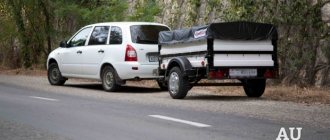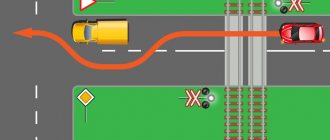Regulatory and legal framework
The main document regulating transportation is the “Road Rules”. Traffic rules 2021 were developed taking into account the shortcomings identified in previous editions. Compliance with them reduces the risk of traffic accidents, since uniform rules appeared in 1931. Since then, they have been supplemented and republished annually.
The fine for an excess passenger is established by the Code of Administrative Offences. This normative document approves the list of administrative crimes and regulates the procedure for bringing to justice for their commission.
Important! Violating the rules for transporting passengers easily leads to serious harm to health when involved in an accident, which threatens the driver with punishment in accordance with Article 264 of the Criminal Code of Russia.
When do inspectors issue a fine for overloading?
In fact, in practice, fines for overloading cars are practically never issued. At traffic police checkpoints, mainly trucks are checked, since overloading of heavy vehicles is the most likely and most dangerous.
However, if a passenger car clearly stands out due to its low rear position, then at the measuring point it may attract the attention of traffic police inspectors. There is also a possibility that at such a point there is automatic recording of violations using a camera and a measuring device, but the likelihood of receiving a fine in this way is even less, since the State Traffic Inspectorate database does not have information about the permissible weight of each car.
Most of all, car drivers should worry about fines for an extra passenger. Finding it is not as difficult as it might seem, since the inspectors at the posts look quite carefully at every passing car.
Number of seats in the vehicle
As stated earlier in the article, the number of seats in the car is determined by its technical characteristics, or rather, indicated in the “Body” paragraph of the PTS.
Important! Recording in the “five-seater” format does not mean that it is allowed to transport five fellow travelers in a passenger car, since this number includes the driver himself, and the maximum number of passengers is 4 people.
Most passenger cars have exactly these characteristics, but the families of many Russian residents consist of a larger number of members, and everyone needs to be transported. It is possible to transport 6 or more people in one car even if the driver only has a category B license.
Expert opinion
Artemyev Dmitry
Experience as a forensic expert in the field of automotive technical examination for more than 2 years, more than 3 years of work in the field of insurance disputes, appealing guilt in road accidents.
Ask a Question
The fact is that such a license allows you to drive vehicles with eight passenger seats. The number of six-seater passenger cars on the Russian market is large; vehicles with a large number of passenger seats are also available to domestic motorists. For example, AvtoVAZ produces the Lada Largus and UAZ Patriot, and most foreign automakers supply multi-seat crossovers and minivans.
Why is overload dangerous?
If the law provides for punishment for some action, then it carries a certain social danger.
Overloading a car also has negative consequences:
- Reduced road safety. An overloaded car handles much worse, its braking distance increases significantly and the likelihood of skidding (especially if the load is not secured). All this can provoke a traffic accident.
- Load on the vehicle structure. When driving an overloaded car, hitting a hole, driving over a bump or speed bump at high speed can cause damage to the car, for example, damage to the frame or shock absorbers.
- Damage to the road surface. In Russia, asphalt on highways wears out quite quickly, and overloaded vehicles accelerate this process even more. Although this point primarily applies to heavy vehicles.
Prohibition on the carriage of unnecessary goods in traffic regulations
The transportation of people in cars is regulated by Article 22.8 of the “Road Rules”.
It states that it is prohibited to move people:
- Outside the vehicle interior, except when using a body or trailer specially equipped for these purposes.
- In quantities greater than indicated in the technical specifications of the vehicle.
Please note that some vehicles allow the carriage of people standing and no fine will be issued for transporting excess passengers if their number does not exceed that specified in the PTS.
However, paragraph 3 of Article 22 of the Traffic Regulations indicates situations in which a person must be provided with a separate seat:
- When transported in the back of a truck.
- When the bus is driving in the mountains or on an intercity route.
- When transporting children in a group.
- When conducting excursions.
What types of overloads are there?
You can overload a car with cargo, or you can overload it with people - there are different penalties for this. It is also worth paying attention to the fact that trailers also have a maximum permissible weight, exceeding which can result in a fine.
- Overload with cargo. If you exceed the maximum permissible weight of a passenger car specified in the STS, then the punishment will be imposed under Art. 12.21. In this case, it does not matter what exactly caused the overload: additional objects, tuning elements or people - what is important is the very fact that the equipped car weighs more than the manufacturer expected.
- Overload of passengers. If the maximum permissible weight is not exceeded, but there are more people in the car than seats, then a completely different article is used - 12.23. Additionally, you can receive a fine for an unbelted passenger, since these fines can be imposed jointly.
- Trailer overload. It is prohibited to overload not only the car itself, but also its trailer, which is also considered a vehicle. The maximum weight of the trailer is also indicated in its STS, and the same fine of 500 rubles is imposed for overloading. according to Art. 12.21. If, according to the documents, the trailer is considered a cargo trailer, then the punishment for it will be much more severe - under Art. 12.21.1, providing for penalties of 1,000 rubles. up to 10,000 rubles, and in some cases, deprivation of rights for up to six months.
What does the fine consist of?
The penalty for transporting passengers in the cabin in excess of the norm is regulated by Article 12.23 of the Code of Administrative Offenses of the Russian Federation and is 500 rubles. The fine for overloading a passenger car with people transported outside the passenger compartment (trunk, hood, etc.) is 1,000 rubles.
Important! The amount of fines issued in accordance with Article 12.23 of the Code of Administrative Offenses does not depend on the number of passengers transported incorrectly, that is, for transporting four or five people in the back seat, the fine is the same.
Please note that the penalty for violating paragraph 8 of Article 22 of the Traffic Regulations is not limited to a fine. After all, the extra passenger carried in the rear is not wearing a seat belt, since the car simply does not have such an additional device. This means that the driver receives a punishment in accordance with Article 12.6 of the Code of Administrative Offenses, which imposes a fine of 1,000 rubles on the driver for an unfastened passenger.
Thus, the final amount of punishment could be:
- 1500 rubles for exceeding the limit of people on seats.
- 2000 rubles for incorrectly transporting passengers outside the vehicle
- 2500 rubles for transporting extra people simultaneously inside and outside the cabin.
Please note that if you are fined for having an extra person in the car, this does not mean that you can continue driving with overload; traffic police inspectors have every right to issue the order again, since the violation has not been eliminated.
From the video you will find out what fine a driver can expect for overloading a car:
What are the dangers of overloading a passenger car?
Overloading a car is one of the most serious traffic violations. Such vehicles are an increased danger on the road, since the driver may at any time lose control, which will cause serious harm to the health of passengers and other road users. In addition, loaded vehicles damage the highway surface.
According to the Code of Administrative Offenses of the Russian Federation, the concept of “vehicle weight” includes:
- Curb weight;
- Full mass;
- Permissible weight limit.
The curb weight is determined without cargo, but with the vehicle fully equipped. The second arises when you have luggage. The permissible weight of a vehicle is indicated by the government structure in perspective and allows you to calculate how a vehicle will behave with a specific distance between two axles. An overloaded car creates traffic accidents on the road, as it can break down and suddenly change its trajectory. Overweight also leads to the following consequences:
- Rapid wear: tires, engine, clutch;
- Instability of the car, as well as overweight to the side even at low speed, skidding to the sides and overturning when the load is poorly secured;
- Destruction of the road surface due to the constant driving of large-sized special equipment;
- Excessive fuel consumption;
- Slowing down the vehicle: maneuverability, dynamics, braking capabilities, which provokes collisions and accidents on the road.
For passengers, this is a direct threat to life and health.
If there is excess cargo
When transporting cargo in a passenger car, the traffic police inspector is guided by the total weight of the car, which is indicated in the technical specifications. However, it is allowed to transport large items up to 1,500 kg. If the load exceeds this mark, the owner creates obstacles not only for other drivers, but also for himself. In these cases, the traffic police officer has the right to evacuate the car for a fine - parking, while issuing an administrative penalty in the amount of 5 thousand rubles.
When carrying excess passengers
The established number of permissible passengers in the cabin is clearly stated in the technical passport for the car. For safety purposes, every citizen is provided with a seat belt that can protect them in the event of an accident. However, not all drivers follow this rule, putting their lives, the health of passengers, and other drivers in danger.
According to the Code of Administrative Offenses of the Russian Federation, the permissible number of passengers in a passenger car is 4 adults and no more than 1 child, who must be in the back seat of the vehicle in a special car seat. This rule applies to all children under 8 years of age.
Rules for the carriage of goods
It is obvious that different types of vehicles (VVs), due to their technical characteristics, have different carrying capacity. The maximum permissible standards are indicated in the individual vehicle passport (PTS). And exceeding these indicators is unacceptable. Loading standards are calculated by the machine manufacturer based on its technical parameters.
The weight of the transported cargo is specified in the accompanying documents, namely, in the consignment note. Loading is carried out in the mandatory presence of an authorized employee of the carrier company (special employee or driver).
It is important that the objects being transported are properly placed in the body, container, tank or trailer. Failure to ensure uniform distribution or poor fastening can lead to displacement and imbalance of the load, as a result - to a decrease in vehicle controllability and the creation of preconditions for an accident.
It is allowed to increase the maximum weight transported by a specific vehicle. But in this case it is necessary:
- obtain a special permit from Rosavtodor in the loading region;
- approve the route there;
- pay compensation for potential damage that will be caused to the roadway.
Overload with cargo
The most common question from a driver who uses his car when moving or transporting goods is: “Have I overloaded my car with excess cargo?” And of course, the driver is interested in whether there is a fine for overloading.
For overloading a car with cargo, you are fined under Article 12.21 of the Code of Administrative Offences, the fine will be 500 rubles or a warning.
Article 12.21. Violation of cargo transportation rules and towing rules
1. Violation of the rules for the carriage of goods, as well as the rules of towing -
entails a warning or the imposition of an administrative fine in the amount of five hundred rubles.
Overload also threatens:
- Wear and tear of the car - first of all, the suspension wears out,
- Increased fuel consumption,
- Loss of control - if you overload, for example, the roof of a car with a load, the center of gravity shifts, which means the car will have different parameters for entering a turn. Not taking them into account means going off the track.
Transporting passengers in a cargo vehicle
The requirements for transporting passengers in a cargo vehicle are very stringent. The latter are only allowed to be located in the truck cabin. And only if this is required by the design of the machine.
Transportation in the back of a truck is permissible only in the following cases:
- If the driver has opened category C or C1, and at least 3 years ago.
- If there are no more than 16 passengers, categories D or D1 are acceptable for their transportation. If you plan to transport more than 16 people, then in this case only category D is required.
- The number of passengers must correspond to the number of seats in the car; as for the seat backs, they must be strong and reliable.
- When transporting passengers in the back, car seats must be installed in such a way that they are up to half a meter from the floor level, and at least 30 cm from the top edge.
As for transporting children in the back of a cargo vehicle, this is strictly forbidden.
In situations where a vehicle is engaged in regular transportation of passengers, the number of people must correspond to the number of seats provided by the design of the vehicle.
Currently, there are situations when a vehicle, such as a bus, is only allowed to accommodate seated passengers. This rule applies in situations such as:
- In case of intercity transportation.
- When traveling through mountainous areas.
- If the bus is used for excursions.
- When transporting children.
As for other cases, standing passengers are allowed in the vehicle.










